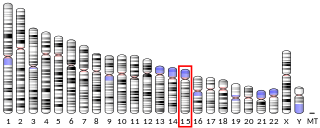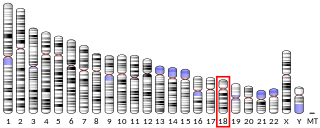Related Research Articles

Glycoproteins are proteins which contain oligosaccharide chains (glycans) covalently attached to amino acid side-chains. The carbohydrate is attached to the protein in a cotranslational or posttranslational modification. This process is known as glycosylation. Secreted extracellular proteins are often glycosylated.

Mannose is a sugar monomer of the aldohexose series of carbohydrates. It is a C-2 epimer of glucose. Mannose is important in human metabolism, especially in the glycosylation of certain proteins. Several congenital disorders of glycosylation are associated with mutations in enzymes involved in mannose metabolism.
Magnesium transporters are proteins that transport magnesium across the cell membrane. All forms of life require magnesium, yet the molecular mechanisms of Mg2+ uptake from the environment and the distribution of this vital element within the organism are only slowly being elucidated.

Acid alpha-glucosidase, also called α-1,4-glucosidase and acid maltase, is an enzyme that helps to break down glycogen in the lysosome. It is functionally similar to glycogen debranching enzyme, but is on a different chromosome, processed differently by the cell and is located in the lysosome rather than the cytosol. In humans, it is encoded by the GAA gene. Errors in this gene cause glycogen storage disease type II.
Env is a viral gene that encodes the protein forming the viral envelope. The expression of the env gene enables retroviruses to target and attach to specific cell types, and to infiltrate the target cell membrane.

Solute carrier family 22 member 1 is a protein that in humans is encoded by the gene SLC22A1.

Adenylyl cyclase type 5 is an enzyme that in humans is encoded by the ADCY5 gene.

Neutral alpha-glucosidase C is an enzyme that in humans is encoded by the GANC gene.

Neutral alpha-glucosidase AB is an enzyme that in humans is encoded by the GANAB gene.

Endoplasmic reticulum mannosyl-oligosaccharide 1,2-alpha-mannosidase is an enzyme that in humans is encoded by the MAN1B1 gene.

Dolichyl-diphosphooligosaccharide—protein glycosyltransferase subunit DAD1 is an enzyme that in humans is encoded by the DAD1 gene.
An Error has occurred retrieving Wikidata item for infobox Magnesium transporter protein 1 is a protein that in humans is encoded by the MAGT1 gene.

Non-imprinted in Prader-Willi/Angelman syndrome region protein 1 is a protein that in humans is encoded by the NIPA1 gene. This gene encodes a potential transmembrane protein which functions either as a receptor or transporter molecule, possibly as a magnesium transporter. This protein is thought to play a role in nervous system development and maintenance. Alternative splice variants have been described, but their biological nature has not been determined. Mutations in this gene have been associated with the human genetic disease autosomal dominant spastic paraplegia 6.

Beta-1,3-galactosyltransferase 5 is an enzyme that in humans is encoded by the B3GALT5 gene.

Urea transporter 2 is a protein that in humans is encoded by the SLC14A2 gene.

UDP-N-acetylglucosamine transferase subunit ALG13 homolog, also known as asparagine-linked glycosylation 13 homolog, is an enzyme that in humans is encoded by the ALG13 gene.

SLC41A1 is a protein that in humans is encoded by the gene SLC41A1. It is homologous to the prokaryotic Mg++ transfer protein MgtE

XMEN disease is a rare genetic disorder of the immune system that illustrates the role of Mg2+ in cell signaling. XMEN stands for “X-linked immunodeficiency with magnesium defect, Epstein-Barr virus (EBV) infection, and neoplasia.” The disease is characterized by CD4 lymphopenia, severe chronic viral infections, and defective T-lymphocyte activation. Investigators in the laboratory of Dr. Michael Lenardo, National Institute of Allergy and Infectious Diseases at the National Institutes of Health first described this condition in 2011.

STT3A, catalytic subunit of the oligosaccharyltransferase complex is a protein that in humans is encoded by the STT3A gene.
Metal transporter CNNM3 is a human transmembrane protein which is made up of 707 amino acids. Although CNNM3 is ubiquitous, it is mostly present in the kidney, brain, lung, spleen, heart and liver.
References
- 1 2 Goytain A, Quamme GA (April 2005). "Identification and characterization of a novel mammalian Mg2+ transporter with channel-like properties". BMC Genomics. 6: 48. doi:10.1186/1471-2164-6-48. PMC 1129089 . PMID 15804357.
- 1 2 Matsuda-Lennikov M, Biancalana M, Zou J, Ravell JC, Zheng L, Kanellopoulou C, et al. (September 2019). "N-linked glycosylation and expression of immune-response genes". The Journal of Biological Chemistry. 294 (37): 13638–13656. doi: 10.1074/jbc.RA119.008903 . PMC 6746436 . PMID 31337704.
- 1 2 Ravell JC, Matsuda-Lennikov M, Chauvin SD, Zou J, Biancalana M, Deeb SJ, et al. (January 2020). "Defective glycosylation and multisystem abnormalities characterize the primary immunodeficiency XMEN disease". The Journal of Clinical Investigation. 130 (1): 507–522. doi:10.1172/JCI131116. PMC 6934229 . PMID 31714901.
- 1 2 Zhou H, Clapham DE (September 2009). "Mammalian MagT1 and TUSC3 are required for cellular magnesium uptake and vertebrate embryonic development". Proceedings of the National Academy of Sciences of the United States of America. 106 (37): 15750–5. Bibcode:2009PNAS..10615750Z. doi: 10.1073/pnas.0908332106 . PMC 2732712 . PMID 19717468.
- ↑ Trapani V, Shomer N, Rajcan-Separovic E (June 2015). "The role of MAGT1 in genetic syndromes". Magnesium Research. 28 (2): 46–55. doi:10.1684/mrh.2015.0381. PMID 26422833.
- ↑ Li FY, Chaigne-Delalande B, Kanellopoulou C, Davis JC, Matthews HF, Douek DC, et al. (July 2011). "Second messenger role for Mg2+ revealed by human T-cell immunodeficiency". Nature. 475 (7357): 471–6. doi:10.1038/nature10246. PMC 3159560 . PMID 21796205.
- ↑ Chaigne-Delalande B, Li FY, O'Connor GM, Lukacs MJ, Jiang P, Zheng L, et al. (July 2013). "Mg2+ regulates cytotoxic functions of NK and CD8 T cells in chronic EBV infection through NKG2D". Science. 341 (6142): 186–91. Bibcode:2013Sci...341..186C. doi:10.1126/science.1240094. PMC 3894782 . PMID 23846901.
As of this edit, this article uses content from "1.A.76. The Magnesium Transporter 1 (MagT1) Family" , which is licensed in a way that permits reuse under the Creative Commons Attribution-ShareAlike 3.0 Unported License, but not under the GFDL. All relevant terms must be followed.